by Adriane Dorr
To describe Houston as big is no overstatement. As the heart of the fourth-largest metropolitan area in the United States, Houston is a city of big buildings, big avenues, big ideas, and a dynamic multicultural population in a big, boisterous state. A lynchpin in the economy of Texas and the Gulf region (not to mention Latin America), it is a hub of activity and commerce. And as part of the LCMS Texas District, it is also home to a vibrant collection of Lutheran congregations and schools that share the Good News of Jesus with an increasingly diverse community.
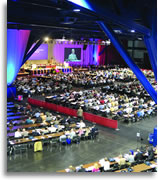 |
|
Photo courtesy LCMS/
|
For the second time this millennium, Houston was also the destination of delegates to a gathering of The Lutheran Church—Missouri Synod. From July 10 to July 17, delegates and visitors gathered at the cavernous George R. Brown Convention Center for the Synod’s 64th Regular Convention. On the agenda: a host of issues. Yet, two items dominated the thoughts of many: Who would be elected president? And would the recommendations of the Synod’s Blue Ribbon Task Force on Synod Structure and Governance, created by Synod President Dr. Gerald B. Kieschnick in 2005, be affirmed? The two items seemed inexorably linked. Probably, the endorsement of one would signal the success of the other. Or vice versa. As things turned out, delegates had other ideas.
Electing a President
On Tuesday afternoon, July 13, the hot Houston air was as still outside the George R. Brown Convention Center as the much cooler air was inside the building. After months of robust and sometimes passionate debate, theological discussion, Facebook fan groups, YouTube videos, and mass mailings supporting either Kieschnick— the current LCMS president—or his chief opponent, Rev. Matthew C. Harrison, executive director of LCMS World Relief and Human Care, some 3,000 convention participants—including roughly 1,200 clergy and lay voting delegates—waited in silence as the votes for president were tallied. Then, Rev. Russell Sommerfeld, president of the LCMS Nebraska District and chairman of the Floor Committee on Registration, Credentials, and Elections, announced: “Matthew C. Harrison is declared elected with 643 votes, 54 percent of the vote.”
The Synod had a new leader.
With his arm around Kathy, his wife, Harrison, 48, made his way from the back of the convention hall and ascended the convention stage to be announced as the new president of The Lutheran Church—Missouri Synod. He and Kieschnick embraced, and then Harrison addressed the delegates. He will serve as the 13th president of the LCMS, following Kieschnick’s nine-year, three-term presidency.
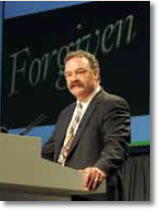 |
|
Rev. Matthew C. Harrison LCMS President-ElectPhoto courtesy LCMS/
|
Speaking briefly (see “Suffering Together, Rejoicing Together“), Harrison reiterated the convention’s theme: “ONE People—Forgiven.”
As director of the church’s mercy arm since 2001 and a member of the boards for Lutheran World Relief, Baltimore, and Lutheran Services in America, Harrison is best-known for coordinating numerous disaster-relief efforts following such catastrophes as the tsunami in Asia, Hurricane Katrina, and the recent earthquake in Haiti.
Pastoral delegate Jared Melius of Denver, Colo., who voted for Harrison, noted, “Pastor Harrison has a pastoral heart, genuine zeal for Lutheran missions, and a desire to unite the Synod around the Gospel of Jesus Christ.”
“Working toward healing is something that has to begin in each of us, including me,” Harrison said. Speaking both to the delegates on the convention floor as well as those who watched the convention live online, he pledged to “do my best, by the word of Christ, to lead with the generous Gospel of Jesus Christ, which forgives us all of our sins and motivates us to love and care for our neighbor in mercy and compassion.”
The election concluded with a display of unity as convention attendees rose to sing the Doxology in acknowledgement of Kieschnick’s service and then quickly pledged unanimously to work together, despite differences, to further the work of the Church.
Following the election, Kieschnick also took a moment to address the delegates, reflecting on his time of service: “It’s been a humbling burden and awesome privilege,” he said, “and I pray the Lord will continue to richly bless this beloved church body that I will always love and will always serve.”
Synod Restructuring
Harrison’s election followed several days of polite yet intense and passionate discussion regarding resolutions drawn up by the Floor Committee on Synod Structure and Governance, which had formed the recommendations of the Blue Ribbon Task Force on Synod Structure and Governance (often referred to by its initials as the “BRTFSSG”) into resolutions.
The task force was appointed by Kieschnick in 2005 to complete “a thorough, zero-based assessment on the system of governance and organizational structure of The Lutheran Church—Missouri Synod,” according to “Congregations Walking Together in Mission,” the task force’s final report.
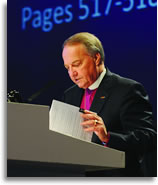 |
|
Dr. Larry Stoterau presented the findings of the BRTFSSGPhoto courtesy LCMS/
|
Dr. Larry A. Stoterau, president of the Pacific Southwest District and chair of the committee, led the discussions on behalf of the committee when the issue came before the assembly on Sunday, July 11. Since the basic structure under which the Synod currently operates was created at its inception 163 years ago, the task force determined that “what worked for 14 congregations doesn’t work for 6,000 congregations,” Stoterau said.
The BRTFSSG ultimately concluded that the Synod’s current organization needed to be realigned to reflect that “the heart of Synod structure is the local congregation,” Stoterau explained. Rev. David Buegler, the Synod’s fifth vice-president and vice-chair of the floor committee, told delegates that this will “put power in the hands of the congregation.”
The biggest change came with Res. 8-08A, a proposal that prompted widespread discussion before the convention and a great deal of debate during it before eventually passing by the narrow margin of 51.9 percent to 48.1 percent (613 votes yes; 568 no). The resolution brings about a significant structural change at the national office in St. Louis, giving more authority to the president and realigning the national Synod around two ministry boards—the Board for National Mission and the Board for International Mission—which, in turn, establish policies and procedures for an Office of National Mission and the Office of International Mission—both of which answer to a chief mission officer (CMO) appointed by the president
with the concurrence of the Board of Directors.
The resolution eliminated nearly all current boards and commissions, although their functions “will still continue in one way or another,” Stoterau said. “The ministries don’t go away just because the boards go away.” The president’s office is now responsible for coordinating not only those efforts but also those of communications, public relations, seminary formation, and other activities.
Christian Preus, a lay delegate who served on the Synod’s Board of Directors from 1995 to 2007, noted his concern with the resolution, saying, “There’s a tremendous amount we don’t know here. This is not going to save money and is sending the authority the wrong way.” Rev. Preston Wagner, Wake Forest, N.C., however, approved of the change: “This resolution is about helping us walk together with great unity. It’s time for us to empower our synodical president to provide servant leadership.”
Carol Booth, lay delegate from Bayside, N.Y., said that observing the restructuring discussion “was a learning experience” and indicated that “in order for churches to move ahead, sometimes they need to look at what worked and what didn’t. Change is hard.”
Harrison publicly opposed the restructuring, believing that it put too much power in the hands of the president. In a paper published before the convention, he wrote that structure was not the issue but instead, “our fundamental problem is one of repentance and lack of faith in the power of the Word to unite even us.” Following the restructuring votes and his own election, he reflected on the irony of the situation: “I did not request this authority and then end up getting elected. It [is] a very humbling reality,” he said.
The floor committee also presented delegates with a BRTFSSG proposal that would have changed the three-year Synod convention cycle to four years in an effort potentially to save millions of dollars. Delegates eventually declined the proposal, opting to leave the cycle as it is.
Other restructuring proposals that gained the approval of the convention include allowing congregations to have a direct say in the election of the president of Synod and the election of Synod vice-presidents two through five on a regional basis. (Currently, only one of Synod’s vice-presidents lives west of the Mississippi River.)
Despite the vigorous debate before the votes on structural overhaul, the delegates were commended several times throughout the week for their cordiality and patience with the process, both from the podium and the floor. “Debate isn’t disunity,” said Gregg Hein, lay delegate from Billings, Mont. “Questions aren’t fighting.”
Rev. Robert Bugbee, president of the Lutheran Church—Canada, who was also in attendance, noted, “We know as partner churches that there are some issues and even elections here that are somewhat contentious, but people have seemed quite mature in the way that they’re handling this. I don’t see disrespect from the floor but rather patience with each other.”
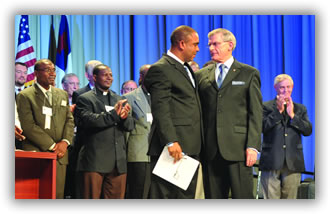 |
Rev. Marky Kessa brought greetings on behalf of the Evangelical Lutheran Church in Haiti
|
Other Actions
Delegates also passed a variety of other resolutions, one of which responded to actions of the Evangelical Lutheran Church in America (ELCA) at its Churchwide Assembly in 2009. In a vote that garnered widespread media coverage, the ELCA decided to acknowledge “publicly accountable, lifelong, monogamous, same-gender relationships” both for laity and those in the pastoral office.
In response, with a vote of 1,133 to 35, the LCMS delegates voted to adopt Res. 3-01A, which affirms the LCMS stance that “God created man and woman for one another” and encourages the Synod to “commend the statement of the ILC, ‘Same-Gender Relationships and the Church,’ for further study and reference.” The statement, drawn up by a task force of the International Lutheran Council (ILC), compares the differences in beliefs between the ELCA and the LCMS regarding Scripture and the way in which the Bible speaks to human sexuality.
Lutheran church leaders from around the globe also spoke to several resolutions brought to the convention floor. Rev. Marky Kessa, president of the Evangelical Lutheran Church in Haiti, and Rev. Revenel Benoit, president of the Lutheran Church Haiti, both took the stage prior to the vote on Res. 6-01, which commended the Synod’s works of mercy in Haiti following the recent earthquake and urged the church to continue disaster response and relief efforts so that the Synod can, according to the resolution, “respond in Christ’s love to our brothers and sisters in need when the next disaster strikes.”
Mourning the loss of 350,000 lives due to the earthquake, Kessa said, “Your spiritual, social, moral, and economic support has kept us going despite all odds.”
For his pastoral care to the people in Haiti, Kessa, joined by other members of his delegation, received a standing ovation from the convention. Moments later, when Res. 6-01 passed by a 99-percent margin, President Kieschnick praised the delegates, saying, “Thank you so much for your support, dear delegates, of this resolution and for your continued support of the church to the terrible condition in Haiti. These are wonderful people of God who are suffering much.”
Dr. Walter Obare, presiding bishop of the Evangelical Lutheran Church of Kenya, also addressed the convention, speaking in favor of Res. 6-04, in which the LCMS would support the “goals of education, advocacy, and fundraising to prevent and contain malaria.”
Speaking to the matter personally, Obare said, “I was number 10 of 15 children. Only five of the 15 children survived malaria, I being one of them . . . If God can grant us grace to see to it that we can do something about it to save a life, it is a needful event.” The resolution passed with 97 percent of delegates voting in its favor.
More Elections
Other elections took place as well. The slate for nominations for first vice-president—consisting of Rev. Herbert Mueller Jr., Dr. William R. Diekelman, Rev. Daniel Preus, Dr. Wallace Schulz, and Dr. Jeffrey Schrank—was also presented to the delegates and approved. Rev. Herbert Mueller Jr., president of the Southern Illinois District since 1994, was elected first vice-president on the first ballot, receiving 31 more votes than the required 600 needed to win.
The remainder of the praesidium was elected as well. Dr. John Wohlrabe, Dr. Paul Maier, Rev. Daniel Preus, and Dr. Scott Murray were elected second through fifth vice-presidents, respectively.
Delegates also elected new members to the Board of Directors for the Synod, as well as that of Concordia Publishing House, Concordia Theological Seminary, Concordia Seminary, the boards of regents of Concordia University System colleges and universities, and the Commission on Theology and Church Relations.
Fan into Flame
Amidst elections and resolutions, delegates received updates on a number of Synod projects, including Fan into Flame, a six-year-old campaign that to date has raised $58.9 million in support of the church’s Ablaze! effort. By adopting Res. 1-01, delegates voted to continue the program until Reformation 2011. The money raised has—and will—continue to fund Ablaze! projects, missionary work, the founding of new congregations, and other outreach efforts.
Attendees also heard about “What a Way,” the Synod’s effort to “rebuild active recruitment and retention of church workers.” Dr. L. Dean Hempelmann, the program’s executive director, noted decreasing numbers of future church workers attending LCMS colleges, universities, and seminaries. Encouraging both pastors and laity to promote the recruitment of church workers, he counseled, “Jesus was urgent in His prayer for the Lord of the harvest to send out workers. There is an urgency that continues for the Church and the world in this day.”
Worship
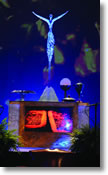 |
|
Photo courtesy LCMS/
|
Worship and daily devotions were also prominent throughout the convention. The opening worship service, hosted by Trinity Klein Lutheran Church, Spring, Texas, took place on Saturday, July 10, and echoed the event’s forgiveness theme. “Offering forgiveness in Word and Sacrament is the business of the church of Jesus Christ that includes The Lutheran Church—Missouri Synod,” Kieschnick said during his sermon. “That is the hallmark of our faith.”
An organ, orchestra, praise band, and adult and children’s choirs provided music for the opening service. Artists at the Center for Liturgical Art at Concordia University Nebraska were responsible for the altar, lectern, and baptismal font used in the service, all of which were then transported to New Orleans for use at the National LCMS Youth Gathering July 17–21. Pastors from the Houston area, as well as the Synod’s 35 district presidents and the praesidium, distributed the Lord’s Supper.
Punctuating the convention proceedings were short “red chair” videos featuring more than 35 district and Synod officials offering personal stories of confession and forgiveness. “The red chair symbolizes our redemption, as Christians, in the blood of Christ,” said Frank Hart, producer of the videos and music director at CrossPoint Community Church in Katy, Texas. The videos are available online at www.lcms.org/redchair.
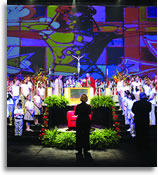 |
|
Photo courtesy LCMS/
|
Pastors also heard private confession and offered absolution throughout the convention, and volunteers staffed a prayer tent on the convention floor. On Friday, July 16, convention chaplain Jotham Johann, associate executive director of the LCMS World Mission National Team, led a Service of Reconciliation during which he thanked the “prayer team of 20 people and the 500 vigil leaders” for their prayers throughout the week.
In keeping with the Church’s historic rhythm of prayer throughout the day, Kieschnick, chair of the convention, halted proceedings each morning and afternoon for attendees to participate in devotions and Bible studies. Ted Kober, founder and president of Ambassadors of Reconciliation, led the majority of Bible studies, which focused on variations of the convention’s theme, “ONE People—Forgiven.”
Greetings
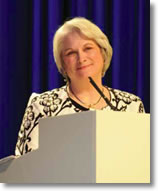 |
|
LWML president Jan WendorfPhoto courtesy LCMS/
|
Throughout the long week of parliamentary procedures, elections, and even humor, from both Kieschnick and the delegates, the assembly received greetings and updates from representatives of partner organizations and churches around the United States and world. LCMS member Jeff Williams, an astronaut who has flown three separate missions in space, brought official greetings to the convention. (Read “Seeing Creation from a Spacecraft Window” for a profile of Col. Williams.)
Key leaders and representatives from other Lutheran church bodies were in attendance throughout the week. These included Rev. Robert Bugbee, president of the Lutheran Church—Canada; Dr. Walter Obare, presiding bishop of the Evangelical Lutheran Church of Kenya; Rev. James Pope of the Wisconsin Evangelical Lutheran Synod; Rev. Franklin Hays of the American Association of Lutheran Churches; and David Swartling, secretary of the Evangelical Lutheran Church in America.
Former presidents and Synod officials in attendance were also recognized: Dr. Robert Kuhn, who served as president for a short time following President A.L. Barry’s death in 2001; Dr. Ralph Bohlmann, who was president from 1981 to 1992; and Rev. Daniel Preus, former first vice-president of the Synod and newly elected fourth vice-president.
Janice Wendorf, president of the Lutheran Women’s Missionary League, greeted the delegates on behalf of the LWML, saying, “It is our pride and joy to be women of the church who serve the Lord with gladness.” Kieschnick commended the work of the LWML, saying, “Without their support, the mission of our Synod would be greatly hampered.”
Delegates also heard from Brad Hewitt, chief executive officer of Thrivent Financial for Lutherans, who noted that, “Lutherans figuring out how to solve problems has resulted in an AA best-rated Fortune 500 company with $70 billion in assets.” Dr. Bruce Kintz, president and CEO of Concordia Publishing House, introduced the delegates to “PrayNow,” an application for iPhones and iPads that offers users the church’s historic daily prayers and Bible readings.
Returning Home
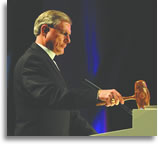 |
|
Photo courtesy LCMS/
|
Kieschnick concluded the convention on Saturday, July 17, with a Trinitarian pounding of the Synod’s historic convention gavel. “May our almighty God lead this church by the Holy Spirit to live as one people forgiven,” he said.
Convention attendees then began boarding shuttles and planes, attempting to wrap their arms around the dramatic structural and ideological shifts that had taken place during the past week. Rev. Michael Kumm, newly elected to the Synod’s Board of Directors, pondered the future, stating, “I believe we must govern by the same standard we use for our theology, that being the Word of God. Stewardship, fellowship, and business decisions should be made in accord with God’s Word and in keeping with our confession of faith.”
The way forward, many delegates acknowledge, will not be easy, nor is it necessarily clear. The implementation of the Synod’s restructuring as well as its impact on local congregations, circuits, and districts remains to be seen. But President-elect Harrison urged patience, saying, “The Lord has given us this, and I have sensed nothing since the election but just a deep hopefulness.” Encouraging prayers on the Synod’s behalf, he promised, “We’ll get through the restructuring, take a deep breath, and we will set our face toward the future and the mission of Christ.”
Harrison and the other officers and board members of Synod take office Sept. 1. They will be installed Sept. 11 at the Chapel of St. Timothy and St. Titus on the campus of Concordia Seminary, St. Louis.
About the Author: Adriane Dorr is managing editor of The Lutheran Witness.
Want More Info?
For more information on convention activities, resolutions, photo galleries, Bible studies, and other activities, visit www.lcms.org, click on “Convention,” then “View the Official Convention Website.”
Also online, as noted, are the heartfelt “red chair” videos. You can find them at www.lcms.org/redchair.





